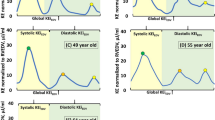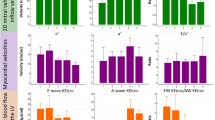Abstract
Objectives
To evaluate the intra-cavity left ventricular (LV) blood flow kinetic energy (KE) parameters using four-dimensional (4D) flow cardiovascular magnetic resonance (CMR) in patients with hypertension (HTN).
Methods
Forty-two HTN patients and twenty age-/gender-matched healthy controls who underwent CMR including cines, pre-/post-T1 mapping, and whole-heart 4D flow imaging were retrospectively evaluated. HTN patients were further divided into two subgroups: with preserved ejection fraction (HTN-pEF) and with reduced ejection fraction (HTN-rEF). KE parameters were indexed to LV end-diastolic volume (EDV) to obtain averaged LV, minimal, systolic, diastolic, peak E-wave, peak A-wave, E-wave, and A-wave KEiEDV, as well as the proportion of in-plane LV KE (%), the time difference (TD). These parameters were compared between the HTN group and healthy controls, also between two subgroups. The correlation of LV blood flow KE parameters with LV function and extracellular volume fraction (ECV) were analyzed in the HTN group using multivariate regression analysis.
Results
Peak E-wave KEiEDV in the HTN group was significantly lower (p = 0.01), while in-plane KE and TD were significantly higher (all p < 0.01) than those in healthy controls. Compared to the HTN-pEF subgroup, the proportion of in-plane KE and TD was significantly increased in the HTN-rEF subgroup (all p < 0.01). Only the proportion of in-plane KE demonstrated an independent correlation with ECV (β* = 0.59, p < 0.01).
Conclusions
The decreased peak E-wave KEiEDV and the increased proportion of in-plane KE, TD reflected the alterations of LV blood flow in HTN patients, and the proportion of in-plane KE was independently associated with ECV.
Key Points
• 4D flow CMR demonstrated that the peak E-wave KEi EDV was decreased, while the in-plane KE and time difference (TD) were increased in hypertensive (HTN) patients.
• The proportion of in-plane KE and TD was further increased in HTN patients with reduced ejection fraction than in HTN patients with preserved ejection fraction, and the proportion of in-plane KE was independently associated with extracellular volume fraction in HTN patients.
• 4D flow CMR intra-cavity blood flow KE parameters might reveal the LV hemodynamic status in preclinical HTN patients.






Similar content being viewed by others
Abbreviations
- 4D:
-
Four-dimensional
- EDV:
-
End diastolic volume
- EF:
-
Ejection fraction
- ESV:
-
End systolic volume
- HTN:
-
Hypertension
- HTN-pEF:
-
Hypertension with preserved ejection fraction
- HTN-rEF:
-
Hypertension with reduced ejection fraction
- KE:
-
Kinetic energy
- LV:
-
Left ventricular
- TD:
-
Time difference
References
Williams B, Mancia G, Spiering W et al (2018) 2018 ESC/ESH Guidelines for the management of arterial hypertension. Eur Heart J 39:3021–3104
Cameli M, Lisi M, Righini FM, Massoni A, Mondillo S (2013) Left ventricular remodeling and torsion dynamics in hypertensive patients. Int J Cardiovasc Imaging 29:79–86
Messerli FH, Rimoldi SF, Bangalore S (2017) The transition from hypertension to heart failure contemporary update. JACC Heart Fail 5:544–551
Pedrizzetti G, La Canna G, Alfieri O, Tonti G (2014) The vortex-an early predictor of cardiovascular outcome? Nat Rev Cardiol 11:545–553
Hussaini SF, Rutkowski DR, Roldan-Alzate A, Francois CJ (2017) Left and right ventricular kinetic energy using time-resolved versus time-average ventricular volumes. J Magn Reson Imaging 45:821–828
Eriksson J, Bolger AF, Ebbers T, Carlhall C-J (2013) Four-dimensional blood flow-specific markers of LV dysfunction in dilated cardiomyopathy. Eur Heart J Cardiovasc Imaging 14:417–424
Ben-Arzi H, Das A, Kelly C, van der Geest RJ, Plein S, Dall’Armellina E (2022) Longitudinal changes in left ventricular blood flow kinetic energy after myocardial infarction: predictive relevance for cardiac remodeling. J Magn Reson Imaging 56:768–778
Prec O, Katz LN (1949) Determination of kinetic energy of the heart in man. Am J Physiol 159:483–491
Kanski M, Arvidsson PM, Toger J et al (2015) Left ventricular fluid kinetic energy time curves in heart failure from cardiovascular magnetic resonance 4D flow data. J Cardiovasc Magn Reson 17:111
Wong J, Chabiniok R, deVecchi A et al (2016) Age-related changes in intraventricular kinetic energy: a physiological or pathological adaptation? Am J Physiol Heart Circ Physiol 310:H747–H755
Garg P, Crandon S, Swoboda PP et al (2018) Left ventricular blood flow kinetic energy after myocardial infarction - insights from 4D flow cardiovascular magnetic resonance. J Cardiovasc Magn Reson 20:61
Garg P, van der Geest RJ, Swoboda PP et al (2019) Left ventricular thrombus formation in myocardial infarction is associated with altered left ventricular blood flow energetics. Eur Heart J Cardiovasc Imaging 20:108–117
Zhuang B, Sirajuddin A, Wang S, Arai A, Zhao S, Lu M (2018) Prognostic value of T1 mapping and extracellular volume fraction in cardiovascular disease: a systematic review and meta-analysis. Heart Fail Rev 23:723–731
Mancia G, Fagard R, Narkiewicz K et al (2013) 2013 ESH/ESC Guidelines for the management of arterial hypertension The Task Force for the management of arterial hypertension of the European Society of Hypertension (ESH) and of the European Society of Cardiology (ESC). J Hypertens 31:1281–1357
Ponikowski P, Voors AA, Anker SD et al (2016) 2016 ESC Guidelines for the diagnosis and treatment of acute and chronic heart failure: the Task Force for the diagnosis and treatment of acute and chronic heart failure of the European Society of Cardiology (ESC). Developed with the special contribution of the Heart Failure Association (HFA) of the ESC. Eur J Heart Fail 18:891–975
Zhong L, Schrauben EM, Garcia J et al (2019) Intracardiac 4D Flow MRI in congenital heart disease: recommendations on behalf of the ISMRM Flow & Motion Study Group. J Magn Reson Imaging 50:677–681
Lotz J, Meier C, Leppert A, Galanski M (2002) Cardiovascular flow measurement with phase-contrast MR imaging: basic facts and implementation. Radiographics 22:651–671
Klein S, Staring M, Murphy K, Viergever MA, Pluim JPW (2010) elastix: a toolbox for intensity-based medical image registration. IEEE Trans Med Imaging 29:196–205
Eriksson J, Bolger AF, Ebbers T, Carlhall C-J (2016) Assessment of left ventricular hemodynamic forces in healthy subjects and patients with dilated cardiomyopathy using 4D flow MRI. Physiol Rep 4:e12685
De Boeck BWL, Oh JK, Vandervoort PM, Vierendeels JA, van der Aa R, Cramer MJM (2005) Colour M-mode velocity propagation: a glance at intra-ventricular pressure gradients and early diastolic ventricular performance. Eur J Heart Fail 7:19–28
Stoll VM, Hess AT, Rodgers CT et al (2019) Left ventricular flow analysis novel imaging biomarkers and predictors of exercise capacity in heart failure. Circ Cardiovasc Imaging 12:e008130
Gaasch WH, Aurigemma GP (2015) CMR imaging of extracellular volume and myocardial strain in hypertensive heart disease. JACC Cardiovasc Imaging 8:181–183
Schumann CL, Jaeger NR, Kramer CM (2019) Recent advances in imaging of hypertensive heart disease. Curr Hypertens Rep 21:3
Dillinger H, Walheim J, Kozerke S (2020) On the limitations of echo planar 4D flow MRI. Magn Reson Med 84:1806–1816
Westenberg JJM, Assen HC, den Boogaard PJ et al (2022) Echo planar imaging-induced errors in intracardiac 4D flow MRI quantification. Magn Reson Med 87:2398–2411
Acknowledgements
The authors thank Jilei Zhang from Philips for his technical support.
Funding
This study was funded by the National Natural Science Foundation of China (No 81871325), Project of STCSM (20Y11911800) and Chongming STCSM (CKY2021-41), and Project of Shanghai Municipal Health Commission (Grant No.20224Y0135) hosted by Kun Peng (the first author of the article).
Author information
Authors and Affiliations
Corresponding author
Ethics declarations
Guarantor
The scientific guarantor of this publication is Guang-Yu Tang.
Conflict of interest
The authors of this manuscript declare no relationships with any companies whose products or services may be related to the subject matter of the article.
Statistics and biometry
No complex statistical methods were necessary for this paper.
Informed consent
Written informed consent was waived by the local ethics committee.
Ethical approval
The local ethics committee approved this study (approval number: 2022 KT19) with the waived written informed consent.
Methodology
• retrospective
• cross-sectional study
• performed at one institution
Additional information
Publisher's note
Springer Nature remains neutral with regard to jurisdictional claims in published maps and institutional affiliations.
Supplementary Information
Below is the link to the electronic supplementary material.
Rights and permissions
Springer Nature or its licensor (e.g. a society or other partner) holds exclusive rights to this article under a publishing agreement with the author(s) or other rightsholder(s); author self-archiving of the accepted manuscript version of this article is solely governed by the terms of such publishing agreement and applicable law.
About this article
Cite this article
Peng, K., Zhang, X., Hua, T. et al. Evaluation of left ventricular blood flow kinetic energy in patients with hypertension by four-dimensional flow cardiovascular magnetic resonance imaging: a preliminary study. Eur Radiol 33, 4676–4687 (2023). https://doi.org/10.1007/s00330-023-09449-8
Received:
Revised:
Accepted:
Published:
Issue Date:
DOI: https://doi.org/10.1007/s00330-023-09449-8




